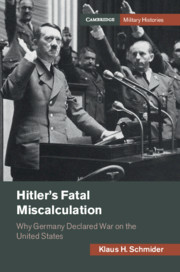Book contents
- Hitler’s Fatal Miscalculation
- Cambridge Military Histories
- Hitler’s Fatal Miscalculation
- Copyright page
- Epigraph
- Contents
- Figures
- Maps
- Preface
- Acknowledgements
- Abbreviations and German and Russian Terms
- Introduction
- 1 Hitler’s Pre-War Assessment of the United States and Japan
- 2 Hitler’s Physical Health in Autumn 1941
- 3 ‘All Measures Short of War’: the German Assessment of American Strategy, 1940–1941
- 4 Forging an Unlikely Alliance: Germany and Japan, 1933–1941
- 5 Facing the Same Dilemma: the US and German Quest for Rubber
- 6 The Crisis of the German War Economy, 1940–1941
- 7 The End of Blitzkrieg? Barbarossa and the Impact of Lend-Lease
- 8 The Battle of the Atlantic
- 9 The Luftwaffe on the Eve of Global War
- 10 The Holocaust
- Conclusion
- Bibliography
- Index
4 - Forging an Unlikely Alliance: Germany and Japan, 1933–1941
Published online by Cambridge University Press: 08 January 2021
- Hitler’s Fatal Miscalculation
- Cambridge Military Histories
- Hitler’s Fatal Miscalculation
- Copyright page
- Epigraph
- Contents
- Figures
- Maps
- Preface
- Acknowledgements
- Abbreviations and German and Russian Terms
- Introduction
- 1 Hitler’s Pre-War Assessment of the United States and Japan
- 2 Hitler’s Physical Health in Autumn 1941
- 3 ‘All Measures Short of War’: the German Assessment of American Strategy, 1940–1941
- 4 Forging an Unlikely Alliance: Germany and Japan, 1933–1941
- 5 Facing the Same Dilemma: the US and German Quest for Rubber
- 6 The Crisis of the German War Economy, 1940–1941
- 7 The End of Blitzkrieg? Barbarossa and the Impact of Lend-Lease
- 8 The Battle of the Atlantic
- 9 The Luftwaffe on the Eve of Global War
- 10 The Holocaust
- Conclusion
- Bibliography
- Index
Summary
Japan began to play a major part in Hitler’s calculations after Italy’s spate of military disasters from November/December had made it clear that Mussolini’s military were turning from asset to liability. From that point onwards, considerable diplomatic leverage was invested into goading the Japanese into joining the war against the UK (January-June 1941) and then, the USSR (July-October 1941). At the same time, German representatives consistently urged the Japanese not to bring the Americans into the war. Bilateral relations between the two would-be allies were far from harmonious, however. Some Japanese spokesmen would make quite specific promises about the imminent participation of Tokyo in the war, while others kept insisting on further German military successes before they would consider making the jump. The pro-German foreign secretary Matsuoka was sacked in July and between May and September 1941, US-Japanese negotiations appeared to presage a détente between both countries and Tokyo’s withdrawal from the Tripartite Pact.
It is against this background that in mid-November a renewed Japanese commitment to enter the war produced a breakthrough. Japanese insistence to extend hostilities to the US might could have turned into a hindrance, but the coincidental abolition of the US Neutrality Law had prepared the ground for US-German hostilities.
Keywords
- Type
- Chapter
- Information
- Hitler's Fatal MiscalculationWhy Germany Declared War on the United States, pp. 163 - 267Publisher: Cambridge University PressPrint publication year: 2021

